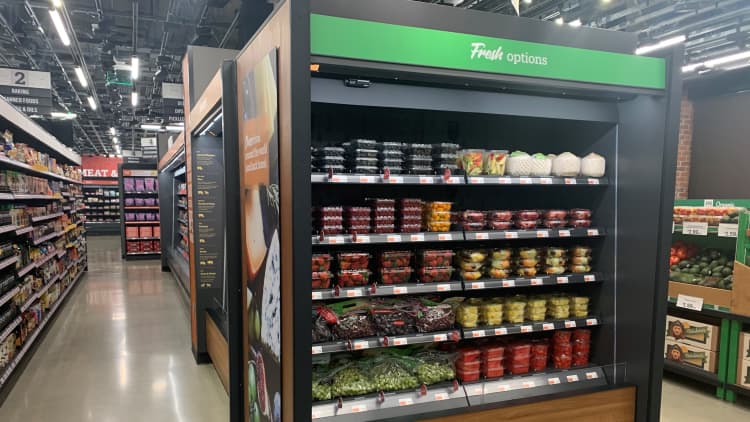
Amazon is launching shopping carts that track items as shoppers add them, then automatically charges them when they remove the grocery bags, allowing them to skip the checkout line.
The Dash Carts will roll out at Amazon's new Los Angeles-area grocery store, which is slated to open this year, the company announced Tuesday.
Dash Carts build on the "Just Walk Out" cashierless technology first deployed at Amazon Go convenience stores. Amazon Go stores, which opened to the public in 2018, let customers buy items without waiting in checkout lines. The company has made inroads into the grocery market over the past several years, but with cashierless technology, Amazon is hoping to make the shopping experience more enjoyable and set itself apart from other physical retailers.
Shoppers must have an Amazon account and a smartphone to use a Dash Cart. After entering the store, users scan a QR code, located in the Amazon app, that signs them into the cart and loads Alexa shopping lists.
Each cart is equipped with cameras that use computer vision to identify items as they're placed in bags inside the cart, and a built-in scale to weigh them if necessary. For items like fresh produce, shoppers type in the item's four-digit code and quantity on the display, which registers the weight and price. The cart is also equipped with a coupon scanner that applies any rebates to the shopper's order. The carts are designed for small- to mid-sized grocery trips, where shoppers might leave the store with one or two bags.
As shoppers add and remove items, a display on the front of the cart adjusts the total price.
When they're ready to leave, shoppers exit via the store's Dash Cart lane. The company charges the credit card linked to their Amazon account and emails a copy of the receipt.
Unlike Amazon Go locations, which offer a variety of on-the-go meals and snacks, the Woodland Hills, California, grocery store resembles a conventional supermarket in its offerings and layout. The Woodland Hills location will be a part of a new chain of Amazon grocery stores, expected to open this year, that the company has been using to fulfill grocery delivery orders during the coronavirus pandemic.
The California store's expanded offerings presented new challenges when Amazon designed the Dash Cart, since the full-size supermarket features a "huge catalog of items," said Dilip Kumar, Amazon's vice president of physical retail and technology.
"You need to be able to add that and keep track of all of that and it just increases the complexity," Kumar said in an interview. "Plus, the weighing component of it also has to be very robust to be able to allow for a very accurate receipt experience for a customer."
Dash Carts are embedded with an array of cameras and sensors, yet, aside from the display, they look just like a standard shopping cart.
"We try to hide that complexity away from customers so you don't have to learn any new shopping behaviors," Kumar said. "Once you're signed in with your phone, you can put the phone away and your normal way that you shop stays the same."
Amazon has continued to expand its cashierless technology beyond its Go convenience stores. In February, it opened its first, full-size, cashierless grocery store, called Amazon Go Grocery, in Seattle's Capitol Hill neighborhood. The store is stocked with about 5,000 items, such as fresh produce, baked goods, meats and household items like paper towels.



